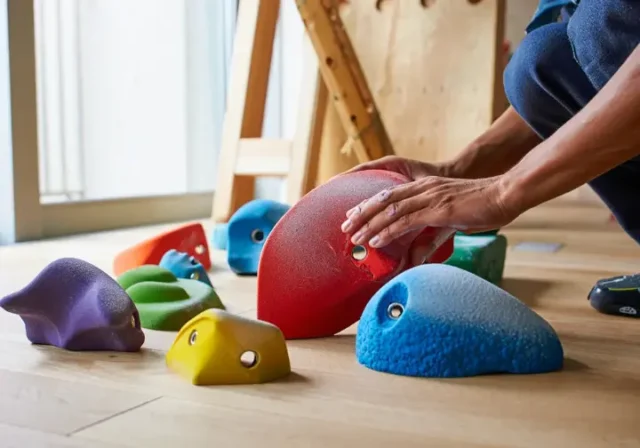In this article
Building a home climbing wall marks an exciting milestone for any dedicated climber. It’s your personal training ground, a canvas where you map out challenges and progress. But staring at a blank wall, the question arises: which climbing holds should you choose? Selecting the right grips can feel like navigating a complex route, determining the character and effectiveness of your climbing space. This guide is your map.
We’ll journey through the essential types of holds, explore the materials they’re made from, and discuss the crucial factors—like your skill level, wall angle, and training goals—that shape your selection. We’ll also touch on reliable brands, hardware essentials, and basic setting principles to transform that rock wall from mere plywood into your personal proving ground. Ready to chart the course and choose the holds that will define your home climbing experience? Let’s begin the ascent.
Understanding Hold Types
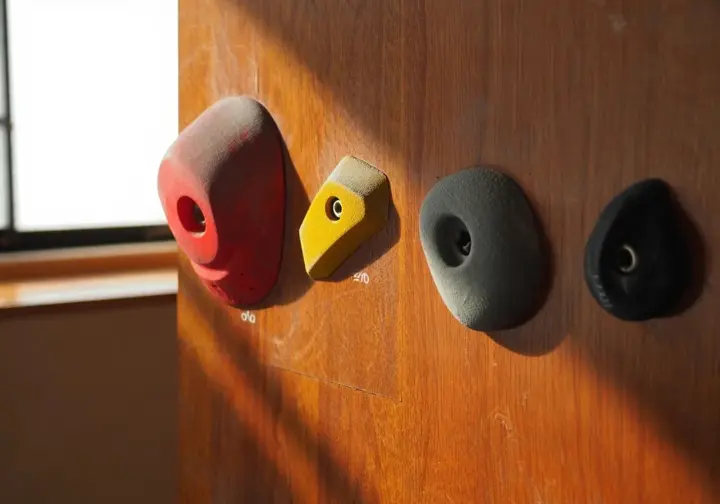
Think of climbing holds as the vocabulary of your wall. Each shape invites a different kind of movement, demands specific techniques, and builds particular strengths. Getting familiar with the fundamental types is the first step in creating routes that are both challenging and rewarding. These climbing handholds are the critical points of contact, the features that turn a blank surface into a vertical playground.
Essential Grip Varieties
Every climbing wall needs a foundation. Jugs or Buckets are the cornerstones – large, positive holds you can wrap your whole hand around, often with an inward curve (incut) for maximum security. They are indispensable for beginners learning the ropes of movement and crucial for warm-ups or finding a moment’s rest on harder climbs. On steep terrain, jugs become lifelines. While secure, even using jugs effectively involves technique; a relaxed grip conserves precious energy.
Next come Edges or Ledges, perhaps the most common type of hold found on rock and plastic alike. These are flat or slightly incut horizontal surfaces, varying immensely in width and depth. Gripping them well means positioning fingers perpendicular to the surface, relying heavily on finger strength. Smaller edges morph into Crimps, demanding significant power from just the fingertips. Mastering edge technique is fundamental, as they appear constantly in rock climbing.
Crimps themselves require careful attention. These small edges test finger strength limits. Climbers use different grips: “open-handed” (fingers arched, less tendon strain) or “full/closed” (thumb reinforcing the index finger for more power, but with a higher risk of injury). Proper body positioning close to the wall is key. Given the stress involved, always ensure thorough warm-ups and gradual loading when training on crimps. We’ve all felt the bite of a sharp crimp without adequate preparation!
Moving away from positive edges, we encounter Slopers. These rounded holds for climbing lack distinct edges, forcing reliance on friction, body tension, and subtle positioning rather than brute finger strength. Maximizing hand surface contact, keeping a low center of gravity, and pulling directly opposed to the hold’s angle are key. They often feel insecure but are invaluable for honing balance and core stability. Have you found slopers particularly puzzling?
Then there are Pinches, gripped by squeezing between the thumb and fingers. This requires specific thumb opposition strength, distinct from edge-pulling power. Pinches vary in width and orientation, demanding a strong, sustained squeeze. Including them ensures well-rounded strength. Pockets, holes fitting one to three fingers, similarly test tendon strength and require precision, especially treacherous single-finger “monos.” Always warm up diligently before tackling powerful pocket moves.
Finally, don’t neglect Footholds or Jibs. These small climbing wall holds, primarily for feet, are crucial for balance, leverage, and precise movement. While sometimes grabbed in desperation, their main role is enabling effective lower body technique. A good selection, from positive micro-edges to tiny smears, is vital for setting realistic and engaging climbs on your rock wall.
Specialized Hold Shapes
Beyond the basics, specialized shapes add complexity and require unique approaches. Underclings, gripped from below with an upward pull, heavily engage the biceps and core. Success often hinges on high feet and pulling the hips close to the wall for leverage. They’re key for navigating certain roof and traverse sequences.
Sidepulls, often vertically or diagonally oriented edges or jugs, demand pulling sideways. This engages muscles differently, often requiring you to turn your opposite hip towards the wall to optimize the pulling angle and maintain balance. Gastons are essentially the reverse, pushing outwards on a side-facing hold near the body, demanding core tension and precise positioning.
Modern setting increasingly uses Volumes or Features. These large structures bolted to the climbing wall fundamentally alter the terrain. Holds can be attached to them, and their surfaces act as large slopers or edges, adding three-dimensionality. Dual Texture Holds represent another innovation, featuring both grippy and smooth surfaces. They force extreme precision, making climbers target only the textured zones – a true test of accuracy.
Material Choices Explored
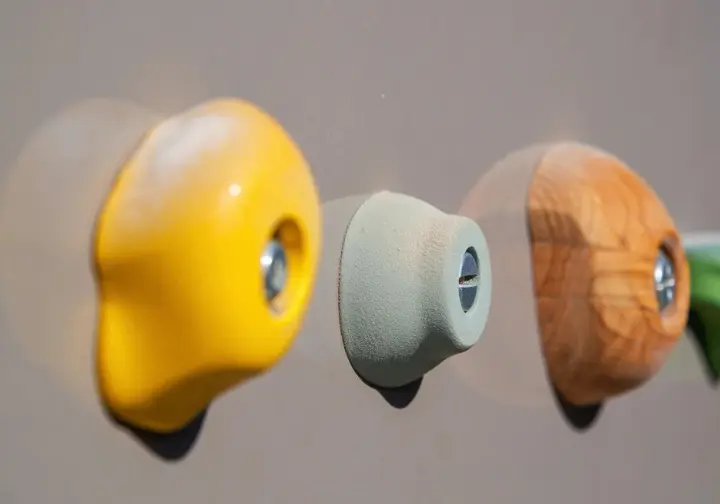
The very substance of your rock climbing holds matters. It affects durability, how they feel under your fingers, their weight, and ultimately, the cost. Let’s delve into the common materials – Polyurethane (PU), Polyester (PE), Wood, and others – to help you choose wisely for your home climbing wall.
PU vs. PE Decision
The current standard-bearer in the climbing hold industry is Polyurethane (PU). Its popularity stems from excellent durability and flexibility. PU resists chipping and breaking far better than older materials, making it safer and ensuring your investment lasts longer, especially under the constant use a home wall often sees. Its lighter weight also allows manufacturers to create hollow-backed designs, enabling larger, more intricate shapes without adding excessive weight to your wall structure. While the initial purchase price for PU holds is typically higher, many climbers find the extended lifespan and safety benefits offer better long-term value. We often hear from home wall owners who wish they’d invested in PU from the start.
The main drawback of PU is that higher upfront cost. Some also note an initial “plastic” feel, though textures vary greatly and often improve with use. There’s some debate about whether the surface texture wears slightly faster than Polyester (PE), but the structural integrity remains sound. Standard PU is also less UV stable, a concern mainly for dedicated outdoor walls.
Polyester Resin (PE), the older common material, offers the primary advantage of being less expensive. This makes PE holds a tempting budget-friendly option, especially when first equipping your wall. They often provide a decent, somewhat rock-like texture and generally handle UV exposure better than standard PU, making them more suitable if your wall gets direct sun.
However, PE’s major weakness is its brittleness. It’s significantly more prone to chipping or cracking, particularly if bolts are over-tightened during installation – a frequent and frustrating mistake. We once saw a brand new PE jug crack simply from being tightened a bit too enthusiastically. PE holds are also heavier, limiting large shapes, and have lower impact resistance. Careful handling is essential.
So, what’s the verdict for your home wall? For most setups anticipating regular climbing, PU is generally the recommended choice. Its superior durability and safety profile justify the higher initial cost for many. PE remains a viable path for those on a tight budget or for lower-traffic walls, provided you install them with care. Consider your expected usage and long-term goals when weighing this decision for your holds for climbing.
Wood and Other Materials
Beyond resins, other materials offer unique characteristics. Wood Holds are prized for being extremely skin-friendly. The lower friction allows for longer training sessions with less wear and tear, ideal for building strength without shredding your hands. They demand precise muscle activation due to less inherent grip, which is excellent for developing power. Plus, many appreciate their natural aesthetic. However, wood is less durable than resin, especially in humid conditions, harder to clean, and offers more limited shape possibilities for rock climbing.
Wood truly shines in specific training applications, particularly hangboards and system boards like the MoonBoard or Tension Board. Here, standardized shapes and skin preservation are key. They are best suited for controlled indoor climbing environments and are also popular among DIY hold makers.
Fiberglass is the material of choice for the large Volumes and Macros that dramatically reshape wall terrain in modern gyms. It boasts an excellent strength-to-weight ratio, enabling huge, hollow structures. While structurally sound, the applied texture can sometimes wear faster than integrated PU/PE textures. High production costs make them less common on typical home walls.
Niche materials like Ceramic Composites (e.g., Synrock) aim to mimic natural rock texture, often praised for a cool-to-the-touch, sandstone-like feel that resists polishing. They can be affordable, but potential downsides include being heavier and more brittle than PU (though improving) and having limited color options. Achieving a finish granite look might be possible with some specialized types. Research also continues into materials like thermoplastics for potential recyclability, while natural stone offers ultimate realism but is impractical for most climbing wall holds.
Key Selection Factors
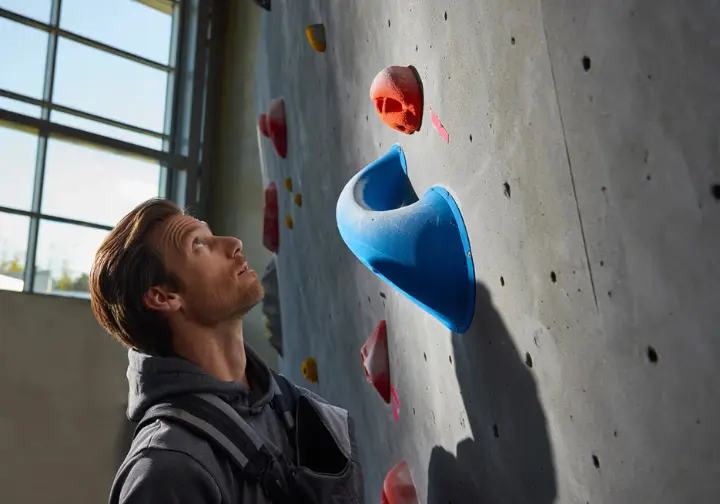
Choosing the right holds goes beyond just liking shapes. It’s about creating a functional and engaging climbing environment. Critical factors include the climber’s skill level, the specific angle of your wall, your training goals, and practicalities like variety, comfort, and budget.
Matching Holds to Climbers
Consider who will be using the wall most. For beginners or if children will be climbing (turning the wall into a vertical playground), a high proportion of large, positive holds like jugs and big edges is non-negotiable. These build confidence and allow learning fundamental movements without frustration. Too many small or difficult holds will quickly become discouraging. Ensure ample easy options exist.
Intermediate climbers benefit from a broader palette to push their skills. Introduce medium-sized edges, varied pinches, manageable pockets, and introductory slopers. This variety helps develop a wider range of techniques and builds the specific strengths needed for harder rock climbing. It’s about bridging the gap to more advanced terrain.
For advanced climbers, the holds must shrink and become less positive, more demanding. This means incorporating various crimps, challenging slopers, awkward pinches, small pockets, and perhaps technical features like dual-texture holds. A wall catering to experienced users needs grips that truly test strength and technique limits.
Regardless of skill level, remember the universal need for jugs. We can’t emphasize this enough. Every home wall needs a good number for safe warm-ups, cool-downs, endurance circuits, practicing movement, downclimbing, and ensuring guests have a positive experience. It’s a common mistake to underestimate how many jugs you’ll actually use. If your wall will host climbers of mixed abilities, ensure the hold selection is diverse enough to offer appropriate challenges for everyone.
Wall Angle & Geometry
The angle of your climbing wall dramatically influences how holds feel. A jug on a vertical wall is easy; that same jug on a 45-degree overhang requires significant effort.
- Vertical Walls (0°): Holds feel relatively positive. Difficulty comes from smaller holds (crimps, tiny edges, slopers) or increased spacing. Excellent for focusing on balance and precise footwork.
- Slight Overhangs (10°-25°): A versatile range. Holds feel harder than vertical, encouraging body tension development, but a wide variety remains usable. Good for mixed-ability training.
- Steep Overhangs (30°-45°+): Gravity rules here. Holds become significantly harder. More positive holds (jugs, incut crimps, deep pockets) are needed even for moderate grades. Core strength and powerful moves are paramount. Have you experienced how different the same hold feels on steep terrain?
The wall angle is arguably the most critical factor in hold selection. Climbing holds perfect for one angle might be unusable on another. Choose holds specifically suited to your wall’s geometry for a functional experience. Moderately overhanging walls (20°-45°) are often considered most versatile, allowing a wide range of climbing styles.
Training Goals & Purpose
What do you want to achieve with your wall?
- General Fitness and Fun: Prioritize variety in shapes, sizes, and colors. Include fun, visually interesting holds. Ensure enough easier options exist for enjoyable sessions. A colorful climbing setup keeps motivation high.
- Strength and Power: Select holds that target specific weaknesses: crimps for finger strength, pinches for thumb power, slopers for open-hand strength. System boards with standardized holds excel here.
- Technique Development: Incorporate holds demanding finesse: slopers, pockets, dual-texture holds, volumes. These force better balance, footwork, and core tension. Set routes requiring specific moves.
- Endurance Training: Requires the ability to set longer sequences. This means a sufficient quantity of holds overall, including rests (jugs, positive holds). Consider if your setup allows linking many moves. Taller walls might even incorporate ropes, though home walls usually focus on bouldering.
- Outdoor Simulation: Training for a specific rock type? Choose holds mimicking its texture and features (granite edges, sandstone slopers, limestone pockets). This makes training highly specific for rock climbing.
Variety, Comfort & Budget
A few final practicalities: Variety is key. A diverse mix of hold types and sizes allows for creative setting and challenges different techniques. Avoid too many similar-feeling holds. Remember, rotating holds dramatically changes their utility. Look for versatile shapes, especially on smaller walls.
Comfort matters. Since you’ll likely spend hours on your home wall, ergonomically shaped holds with smooth edges prevent excessive skin wear and joint tweaks, enabling more consistent training. Texture is a trade-off: rougher grips well but shreds skin; smoother is kinder but harder. Find a balance that works for you; new holds often mellow with use.
Budgeting is crucial. Holds are a major expense. Save by buying starter packs/bulk sets, discounted factory seconds (cosmetically flawed but sound rock climbing holds), or used holds. Balancing cost with quality, especially for core climbing handholds, ensures long-term satisfaction.
Top Sets & Brands
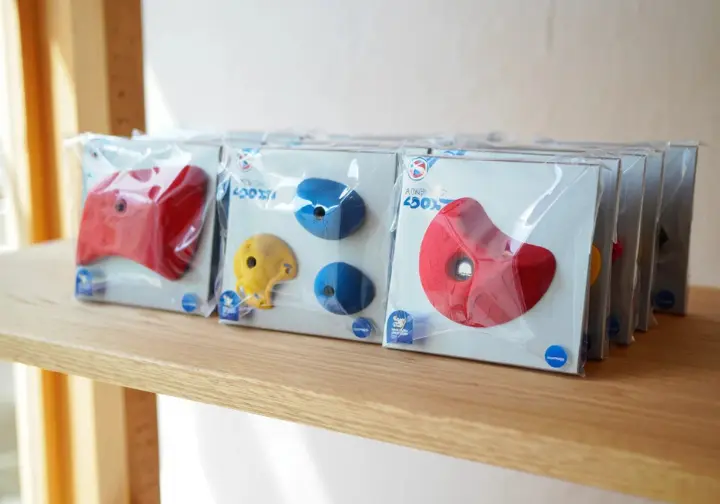
With so many options, where do you start? Here’s a look at some popular brands often seen on home walls, plus tips for finding sets and reviews to guide your climbing gear purchases.
Popular Home Wall Brands
- Atomik Climbing Holds: Known for good value, a huge variety, and budget packs. They offer rock climbing holds in over 60 colors. Texture can sometimes be inconsistent, but they’re a solid starting point.
- Metolius Climbing: Widely available, famous for “Mega Packs.” Cost-effective for quantity, though some question durability on very steep walls compared to premium PU. Often found used.
- So iLL Holds: Stand out for unique, aesthetic shapes and high-quality PU. Offer factory seconds for acquiring their distinct style more affordably.
- Escape Climbing: Diverse range, including dual-texture. Popular source for affordable factory seconds (quality can vary). Standard holds often praised for texture. Escape Climbing is a go-to for many home wall builders.
- Tension Climbing: Premier name for wooden training holds (hangboards, system board holds) and Tension Board systems. High quality, premium price. Also offer PU holds and seconds. Wood texture can be intense.
- Kilter Grips: Premium, comfortable, versatile holds common in gyms and on their LED Kilter Board. Excellent ergonomics, potentially high cost for a full home set.
- eGrips: Often cited for quality shapes, comfort, and durability. Offer specific home gym kits providing a good starting selection.
Finding Sets & Reviews
- Starter Packs/Home Wall Sets: Many companies curate bundles for home walls, aiming for a balanced mix (Metolius Mega Packs, Atomik packs, EP Climbing Packages, etc.). Often better value than buying climbing holds individually.
- Factory Seconds/Overstock: A huge budget saver. Buy structurally sound holds with minor cosmetic flaws from brands like So iLL, Escape Climbing, Tension, etc. Specify needs (angle, difficulty) if possible when ordering.
- Used Holds: Check gym sales or online forums (Mountain Project, Facebook groups). Highly cost-effective, and used holds are often kinder to skin. Inspect carefully for damage.
- Sources for Reviews: Look to climbing magazines, industry sites (Climbing Business Journal), and online communities (Mountain Project, Reddit r/homewalls). General gear reviews focus more on hangboards than specific hold sets.
Hardware & Mounting Essentials
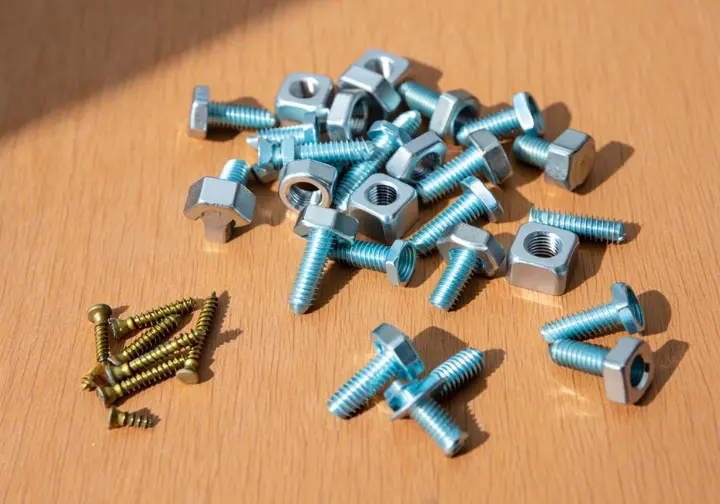
Great climbing holds are useless without secure mounting. Understanding the necessary hardware—T-nuts, bolts, and screws—is critical for safety and ensures your wall is ready for action.
T-Nuts Explained
T-nuts are the threaded inserts installed on the back of your climbing wall panels (usually 3/4″ plywood). They are the anchor points for the bolts. The industry standard is 3/8″-16 thread (requiring a 7/16″ drill hole). Using the standard ensures compatibility.
There are two main types:
- 4-Prong T-Nuts: Common, cheap. Prongs bite into the wood. Downside: prone to spinning or popping out, especially over time, causing major headaches.
- Screw-In T-Nuts (Highly Recommended): Have extra holes for screws, securing them firmly from the back. Drastically reduces spinning/popping issues. Standard in gyms, highly recommended for home walls despite slightly higher cost. Saves immense future frustration for climbers.
Most T-nuts are zinc-plated steel for indoor use; stainless steel is better for outdoors/humidity but costs more. Install T-nuts before mounting wall panels, ensuring they are straight and fully seated. Trust us, the extra cost for screw-ins is worth it to avoid the pain of a single spinner later!
Bolts and Screws
For standard T-nuts, you need 3/8″-16 diameter bolts. Socket Head Cap Screws (SHCS, need 5/16″ Allen key) are most common. Ensure the bolt length is correct: long enough to go through the hold and plywood, fully engaging the T-nut threads. Have an assortment of lengths (1.5″ to 6″+) as part of your gear. Standard indoor bolts are alloy steel; use stainless steel for outdoor walls.
Some smaller holds (especially footholds) are screw-on, attached directly with wood screws anywhere on the wall. Use strong construction screws (#8 or #9 gauge). Crucially, many bolt-on holds have smaller secondary holes for set screws. Always use these! They prevent the hold from dangerously spinning when weighted. This is a vital safety step for every climber.
Setting Your Home Wall
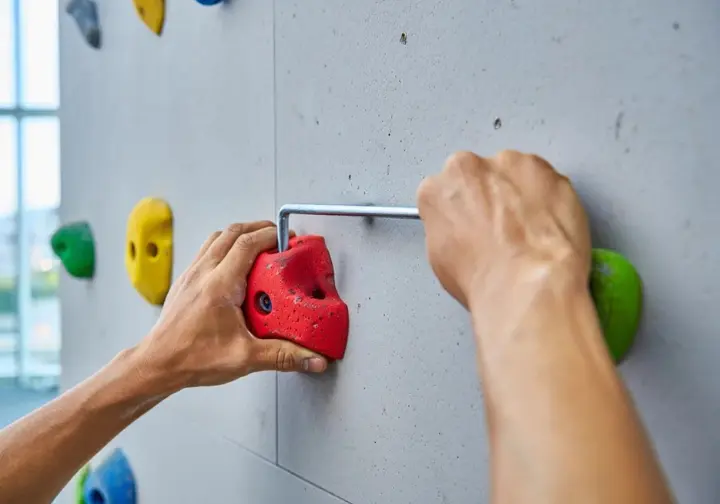
With holds and hardware ready, it’s time to set routes! Arranging holds (density) and applying basic setting principles—focusing on variety, movement, difficulty, testing, and safety—transforms your wall into a dynamic rock climbing training tool.
Hold Density & Layout
How many holds? A common guideline is ~1 hold per square foot for good setting options, mimicking gym density. Training “spray walls” might use more (up to 4/sq ft), while basic setups use less (maybe 0.5/sq ft). Density depends on your goals and budget. Many start moderately (~1/sq ft) and add more holds over time. Installing a dense T-nut grid initially gives maximum future flexibility. Ensure enough holds for a full problem (at least 12 is often cited).
Basic Setting Principles
- Create Varied Movement: Mix hold types, sizes, orientations. Rotate holds – it dramatically changes them! Aim for engaging sequences, not just repetitive pulls on your climbing wall holds. Think flow.
- Control Difficulty: Adjust challenge via hold choice, orientation, spacing, or restricted feet. Small tweaks make big differences.
- Test Everything (Forerun): Climb what you set! This reveals awkward moves, wrong difficulty, poor flow, or spinning holds. Be ready to adjust. We once set a problem that felt impossible until moving one foothold slightly – testing is key for the climber.
- Prioritize Safety: Double-check every hold is tight (bolt AND set screws!). Use set screws diligently. Ensure adequate padding below. Basic safety gear is non-negotiable.
- Seek Feedback: Have others try your routes. Discussing intentions vs. reality improves setting skills. Be open to critique to make your wall better.
Conclusion: Smart Grip Choices
Selecting the right climbing holds for your home wall is a balancing act: skill, angle, goals, variety, materials, budget. Build a solid foundation: plenty of jugs, reliable hardware (screw-in T-nuts!), good footholds. Research brands, read reviews, seek value (packs, seconds) for your rock climbing holds.
Plan carefully for your specific wall and users. Then, start setting! Focus on varied movement, safety, and thorough testing. Get feedback. Your hold collection is dynamic – experiment and evolve it over time to keep your home wall engaging and effective. Get your rock wall today and happy climbing!
Frequently Asked Questions
What’s the most important type of hold for a beginner’s home wall? >
Should I buy PU or PE holds for my home wall? >
How many holds do I need per square foot? >
Why are screw-in T-nuts recommended over 4-prong T-nuts? >
We are a participant in the Amazon Services LLC Associates Program, an affiliate advertising program designed to provide a means for sites to earn advertising fees by advertising and linking to Amazon.com. As an Amazon Associate I earn from qualifying purchases. We also participate in other affiliate programs. The information provided on this website is provided for entertainment purposes only. We make no representations or warranties of any kind, expressed or implied, about the completeness, accuracy, adequacy, legality, usefulness, reliability, suitability, or availability of the information, or about anything else. Any reliance you place on the information is therefore strictly at your own risk. Additional terms are found in the terms of service.



